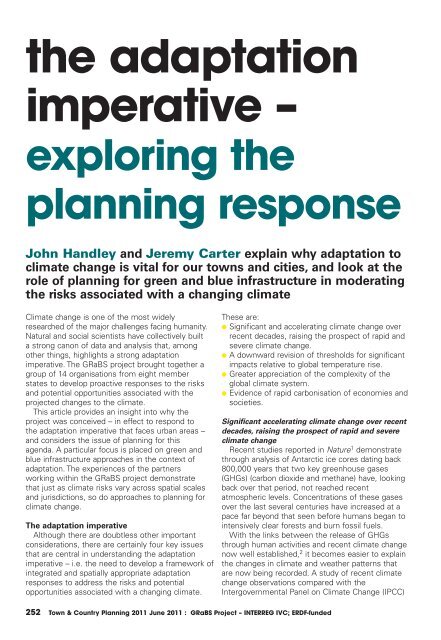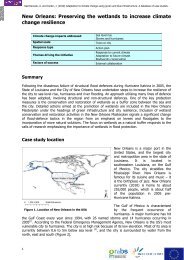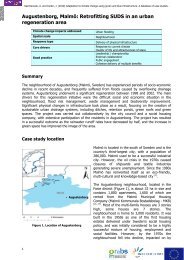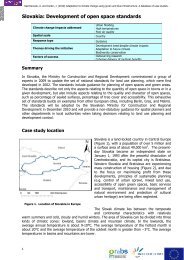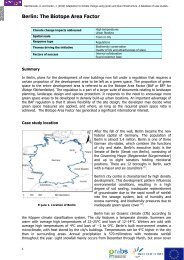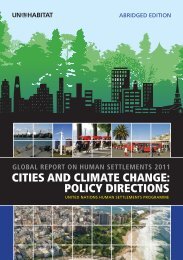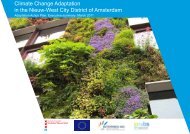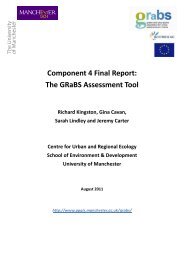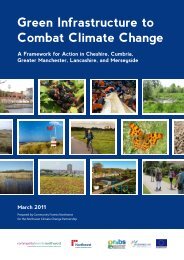Download - GRaBS
Download - GRaBS
Download - GRaBS
Create successful ePaper yourself
Turn your PDF publications into a flip-book with our unique Google optimized e-Paper software.
the adaptation<br />
imperative –<br />
exploring the<br />
planning response<br />
John Handley and Jeremy Carter explain why adaptation to<br />
climate change is vital for our towns and cities, and look at the<br />
role of planning for green and blue infrastructure in moderating<br />
the risks associated with a changing climate<br />
Climate change is one of the most widely<br />
researched of the major challenges facing humanity.<br />
Natural and social scientists have collectively built<br />
a strong canon of data and analysis that, among<br />
other things, highlights a strong adaptation<br />
imperative. The <strong>GRaBS</strong> project brought together a<br />
group of 14 organisations from eight member<br />
states to develop proactive responses to the risks<br />
and potential opportunities associated with the<br />
projected changes to the climate.<br />
This article provides an insight into why the<br />
project was conceived – in effect to respond to<br />
the adaptation imperative that faces urban areas –<br />
and considers the issue of planning for this<br />
agenda. A particular focus is placed on green and<br />
blue infrastructure approaches in the context of<br />
adaptation. The experiences of the partners<br />
working within the <strong>GRaBS</strong> project demonstrate<br />
that just as climate risks vary across spatial scales<br />
and jurisdictions, so do approaches to planning for<br />
climate change.<br />
The adaptation imperative<br />
Although there are doubtless other important<br />
considerations, there are certainly four key issues<br />
that are central in understanding the adaptation<br />
imperative – i.e. the need to develop a framework of<br />
integrated and spatially appropriate adaptation<br />
responses to address the risks and potential<br />
opportunities associated with a changing climate.<br />
These are:<br />
● Significant and accelerating climate change over<br />
recent decades, raising the prospect of rapid and<br />
severe climate change.<br />
● A downward revision of thresholds for significant<br />
impacts relative to global temperature rise.<br />
● Greater appreciation of the complexity of the<br />
global climate system.<br />
● Evidence of rapid carbonisation of economies and<br />
societies.<br />
Significant accelerating climate change over recent<br />
decades, raising the prospect of rapid and severe<br />
climate change<br />
Recent studies reported in Nature 1 demonstrate<br />
through analysis of Antarctic ice cores dating back<br />
800,000 years that two key greenhouse gases<br />
(GHGs) (carbon dioxide and methane) have, looking<br />
back over that period, not reached recent<br />
atmospheric levels. Concentrations of these gases<br />
over the last several centuries have increased at a<br />
pace far beyond that seen before humans began to<br />
intensively clear forests and burn fossil fuels.<br />
With the links between the release of GHGs<br />
through human activities and recent climate change<br />
now well established, 2 it becomes easier to explain<br />
the changes in climate and weather patterns that<br />
are now being recorded. A study of recent climate<br />
change observations compared with the<br />
Intergovernmental Panel on Climate Change (IPCC)<br />
252 Town & Country Planning 2011 June 2011 : <strong>GRaBS</strong> Project – INTERREG IVC; ERDF-funded


